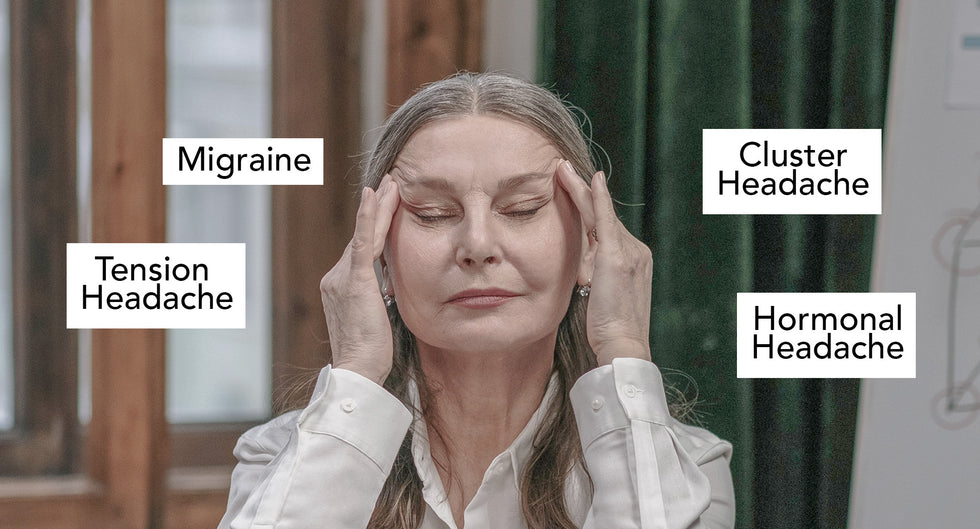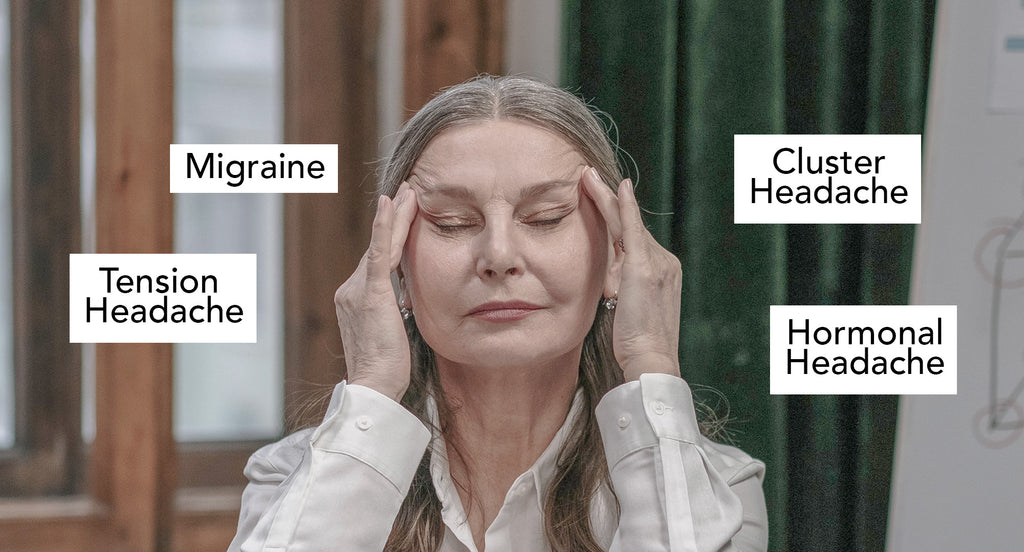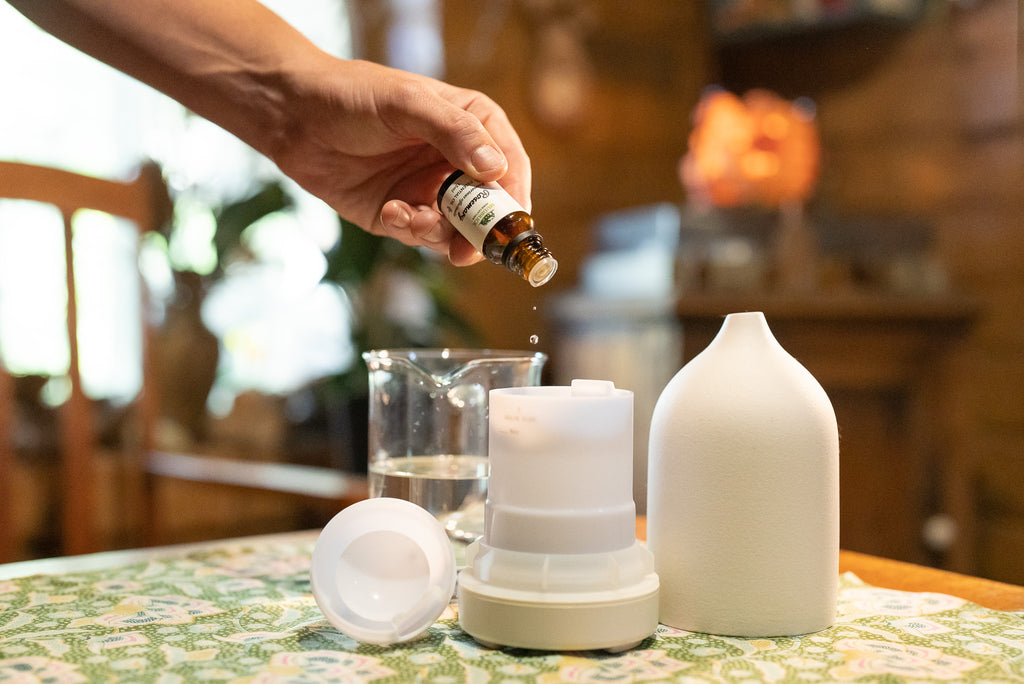5 Best Essential Oils for Headaches and How to Use Them

Are your headaches becoming immune to ibuprofen and acetaminophen? After a while, these over-the-counter medications lose their effectiveness. And if you’re looking for a natural alternative, essential oils may be the headache treatment you need.
Anxiety, stress, migraines, hormones, and serious head injuries can cause headaches. The debilitating pain can make it difficult to go about your day or even open your eyes. Not only can the right essential oils relieve your pain, but they can also reduce stress and promote relaxation, preventing headaches before they begin.
But how?
Essential oils are made by distilling plants with steam or applying mechanical pressure to release the aromatic and therapeutic properties. They’ve been used in traditional medicine for thousands of years and target the root cause of many headaches rather than just the associated pain.

Headaches: Causes, Types, and Common Remedies
Nearly 20% of adults experience frequent headaches, but they’re caused by different factors and present differently in each individual. It’s important to diagnose the causes of your headache as well as the type before treating it with essential oils. Each oil has different properties and application methods, making certain oils better at treating headaches than others.
Causes of headaches
Headaches can be caused by chemical activity in the brain, muscle tension, eye strain, and a number of other factors. And oftentimes, a combination of these factors is to blame.
Most headaches are caused by stress or tension in the neck and head muscles. These headaches, called tension headaches, are caused by emotional stress, poor posture, fatigue, injury, or anxiety. Sports injuries, contusions, falls, concussions, and other blunt-force traumas also cause headaches.
Neurotransmitters like serotonin and dopamine help manage emotions and sensory perceptions. Imbalances in these chemicals can cause headaches or migraines. Serotonin imbalances aren’t fully understood. But according to a 2012 study on migraines, dilated and/or restricted blood vessels cause peptide imbalances which ultimately cause the central nervous system to relay pain signals to your head. The same research suggests fluctuating oestrogen levels may exacerbate serotonin imbalances, which is why women are three times more likely to suffer from migraines.

Most common types of headaches
Tension headache
Tension or stress headaches are the most common type and can last anywhere from a few minutes to several days at a time. They occur when blood vessels become constricted as a result of surrounding muscle tension, reducing blood and oxygen flow to the skull. They typically come on slowly and feel like a dull, aching pain that wraps around the head. Stress, anxiety, and sleep deprivation can cause these headaches as well.
And if left untreated, stress headaches can cause hair loss, mental health disorders, and sleep disturbances.
Migraine attack
Migraine attacks feel like a severe throbbing pain or pulsing sensation that generally affects one side of the head. They can be caused by stress, hormonal fluctuations, sleep deprivation, or external factors like flashing lights, booming sounds, or changes in the weather. Migraine attacks are more common in women. Still, up to 12% of adult men suffer from migraines, and 1% suffer from chronic migraines lasting 15 days at a time, according to a 2014 study.
Severe attacks can be accompanied by nausea, vomiting, and light & sound sensitivity. Kids with migraines often outgrow them. Still, they can return later in life, especially during physical activity or when they get their periods. If your child struggles with migraines, gentle essential oils like peppermint and lavender may help.
Cluster headache
Cluster headaches come on quickly and feel like a sharp sensation on one side of the head. Still, the pain can travel to other areas, including the eyes and temples. These types of headaches are rare; only 0.1% of people have them, so little is known about their nature. Although their exact cause isn’t known, a 2022 study confirms they relate to the hypothalamus, the body’s biological clock.
Hormonal
Hormonal headaches are caused by fluctuating levels of oestrogen or progesterone. These are common during the menstrual cycle, pregnancy, and menopause but may occur anytime. These headaches are similar to migraines and can last minutes or weeks at a time.
Why common remedies aren’t effective at treating headaches
Dehydration is a common cause of headaches, especially in those who lead active lifestyles. And though drinking water is a standard recommendation for treating headaches, it won’t cure your headache. Proper hydration improves the overall quality of life, but according to a 2011 study, “drinking more water did not reduce the monthly headache frequency and duration.”
Lying down in a dark room is a common pain-management method for migraines, as you can eliminate your exposure to bright lights and loud sounds. Lying down may provide temporary relief, but it won’t treat the underlying cause.
Over-the-counter medications are the most commonly used treatments for headaches. However, they have the worst side effects. Medication-overuse, or rebound headaches, are caused when you regularly take pain-relief medications. These usually fade within a few days of stopping the drug, but you must endure the painful side effects until then.
Essential oils target underlying headache pain without adverse side effects. Many have analgesic properties that alleviate headache symptoms. Others, like peppermint, stimulate blood flow while inhibiting muscle contractions, making them ideal for tension headaches.
Treating headaches with essential oils
Certain smells can cause or worsen headaches. For example, strong scents like perfume and cigarette smoke may cause blood vessels in your head to pulsate, leading to a headache or migraine. But, other aromas, such as those used in aromatherapy, can aid in reducing headache symptoms. Essential oils can also alleviate headaches when applied directly to the forehead or temples.
Essential oils target the root cause of your headache. Some, such as lavender, lemon, and ylang ylang alleviate stress, one of the primary causes of headaches. Others, like frankincense and peppermint, reduce inflammation, which has been linked to migraine activity. Essential oils can also relieve headaches caused by blocked sinuses and improve blood flow to the brain.
It’s important to note that essential oils are highly concentrated and may adversely affect some users. If you’re struggling with severe headaches, check with your doctor before considering essential oils as a treatment option.
5 best essential oils for headaches
Peppermint (Mentha piperita)

Peppermint oil treats tension headaches and migraine attacks. Researchers determined peppermint oil’s pain-relief properties are comparable to acetaminophen and aspirin. Another study confirmed that, when inhaled, “peppermint oil caused [a] considerable reduction in the intensity and frequency of headache and relieved [the] majority of patients' pain similar to lidocaine.”
Avoid using peppermint oil before bed, as menthol, its primary component, has a stimulating effect that may keep you awake.
Rosemary (Rosmarinus officinalis L.)

Rosemary essential oil treats tension headaches, migraine attacks, hormonal headaches, and even hangovers. This oil manages headaches in multiple ways. It has anti-inflammatory and pain-relieving properties. Additionally, you can relieve stress, the primary cause of headaches, with rosemary oil and improve blood flow to your brain.
Rosemary oil can boost cognitive performance and protect your brain from long-term decline. This oil has stimulant and mood-boosting properties as well.
Lavender (Lavandula)

Lavender essential oil treats tension headaches from stress & sleep deprivation, migraines, and hormonal fluctuations. It can be used long-term as a preventative treatment for frequent migraines and doesn’t cause unwanted side effects like common headache medications.
Sleep loss is a well-documented trigger for frequent headaches and migraines. You can use lavender oil to go to sleep faster and improve overall sleep quality.
Chamomile (Matricaria chamomilla L.)

Chamomile oil has anti-inflammatory properties that reduce irritated and congested sinuses, relieving sinus headaches. Studies have shown that using chamomile essential oil as a topical treatment effectively alleviates migraine symptoms.
It has anxiolytic (anti-anxiety) properties that prevent stress and anxiety-triggered headaches. Additionally, chamomile oil calms you, helping you relax or fall asleep after a stressful day.
Eucalyptus (Eucalyptus globulus)

Eucalyptus essential oil is commonly used in steam rooms, as it opens your nasal passages, clearing sinuses and relieving sinus headaches. It has anti-inflammatory properties that were shown to relieve headaches and treat common ailments like sinusitis, bronchitis, asthma, and COPD.
Those who frequently feel stressed can use eucalyptus oil to lower their blood pressure and reduce stress-induced headache severity.
How to use essential oils for headaches
Topical
Mix two to three drops of essential oil with a carrier oil like coconut, jojoba, avocado, or olive oil. The mixture should be about 97% carrier oil. Before applying an essential oil to your head, patch test a small area of skin on your arm, ensuring you don’t have an adverse reaction. Rub the mixture directly on your forehead, temples, behind your ears, or back of your neck, targeting the area where the pain is most significant.
Massage your skin with circular motions and breathe deeply to relax and inhale the oils’ aroma. If your headache hasn't faded completely, you can re-apply the mixture after 30 minutes.
If you struggle with frequent headaches, make a roller with this simple recipe:
- Add six drops of peppermint, rosemary, lavender, chamomile, or eucalyptus oil to a 10 ml roller bottle.
- Fill the bottle with fractionated coconut oil or jojoba oil.
- Close the lid and shake it vigorously to mix the oils.
- You can try blending multiple essential oils, but don’t exceed six drops in a 10 ml bottle.
- Store the mixture in a cool, dry place and use as needed.
Inhale from bottle
Inhaling essential oils from the bottle can provide immediate relief as the healing aroma travels from your olfactory nerves to the emotional centre of your brain. This method may be too intense if you’re suffering from a migraine. It’s best to start with a weaker concentration and gradually increase the strength.
Steam inhalation
Heat a bowl of water until it’s steaming, and add a few drops of essential oil. Cover your head with a towel and hold your face over the mixture. Take several deep breaths and close your eyes to avoid irritation.

Diffuser
Essential oil diffusion is an excellent way to reduce cluster headache pain. This method lets you enjoy the benefits of essential oil therapy throughout the day. Follow the directions on your diffuser and consider testing it in a well-ventilated room before using it in your primary living area.

Warm or Cold compress on the back of the neck
Add a few drops of essential oil to a light carrier oil, such as fractionated coconut or jojoba oil. Apply the mixture to a hot or cold damp towel and place it on your neck. Hot compresses are best for tension and hormonal headaches, whereas cold compresses are ideal for sinus headaches. You can also alternate between cold and hot compresses to treat migraines.
Essential oils effectively treat headache pain and the most common causes of headaches like stress, allergies, muscle tension, and congested sinuses. Unlike over-the-counter headache medications, essential oils have no adverse side effects and won’t worsen your headache. Now that you know more about the best essential oils for headaches and how to use them, you’re better equipped to choose the one that treats your primary headache triggers.



